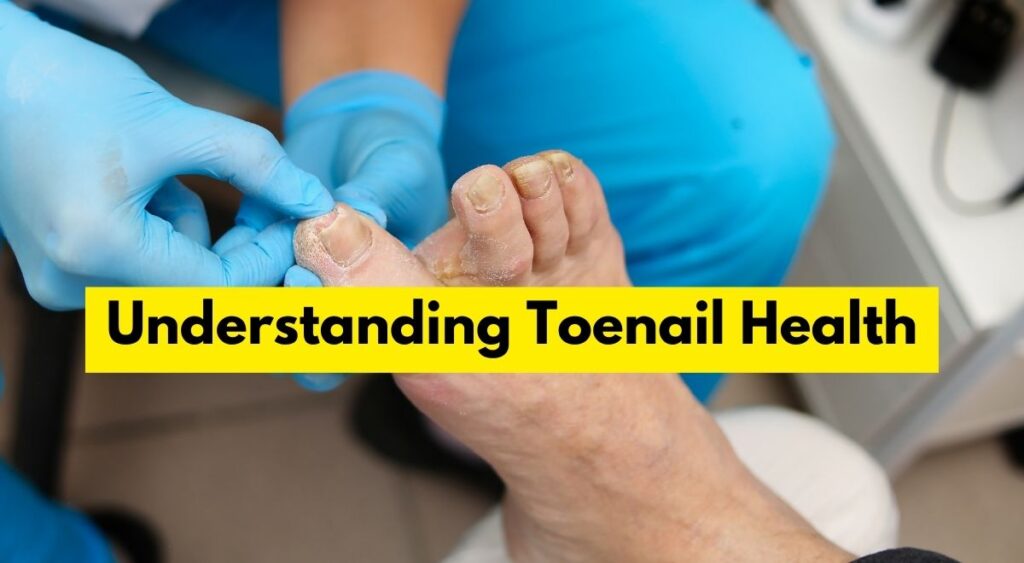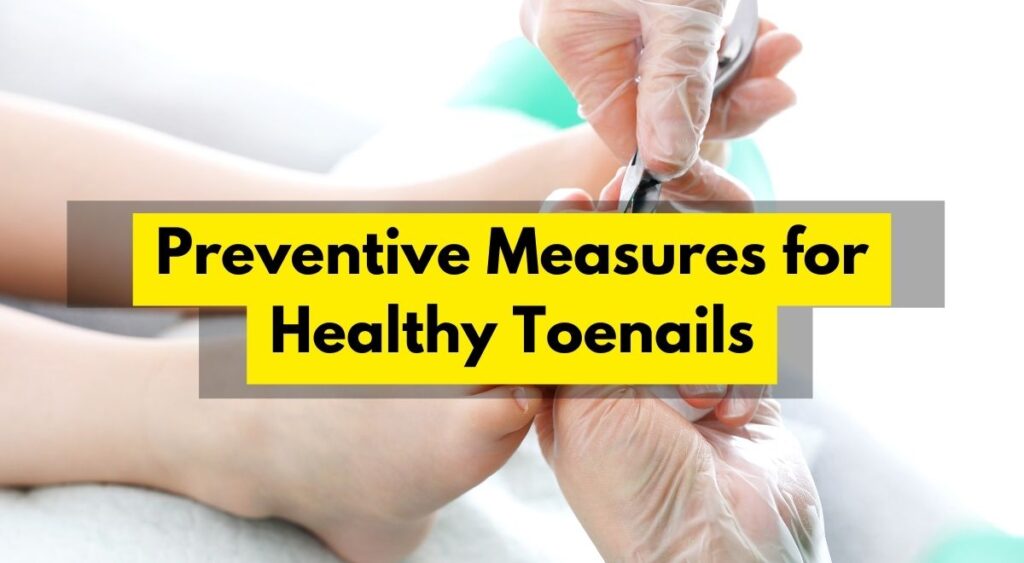1. Understanding Toenail Health

Maintaining healthy toenails is a crucial aspect of overall foot health. Toenails protect the tips of our toes and help with balance and stability. However, they are also susceptible to various problems that can affect their appearance and health. Understanding the basics of toenail health, the common issues that can arise, and how nail growth works can help in maintaining healthy toenails.
Table of Contents
What is Toenail Fungus?
Toenail fungus, also known as onychomycosis, is a common condition that affects the toenails. It is caused by various types of fungi, including dermatophytes, yeasts, and molds. These fungi thrive in warm, moist environments, making toenails particularly vulnerable, especially if they are frequently exposed to such conditions.
Symptoms of toenail fungus include:
- Discoloration of the nail (usually yellow or white)
- Thickening of the nail
- Brittleness or crumbling edges
- Distortion in the shape of the nail
- A foul smell
Toenail fungus can be persistent and difficult to treat, often requiring antifungal medications or other treatments. Preventive measures, such as maintaining good foot hygiene and wearing breathable shoes, can help reduce the risk of developing toenail fungus.
Common Nail Problems
Apart from fungal infections, toenails can be affected by various other problems, including:
Ingrown Toenails:
This occurs when the edge of the toenail grows into the surrounding skin, causing pain, redness, and sometimes infection. It is often the result of improper nail trimming or wearing tight shoes.
Nail Trauma:
Physical injuries to the toenail, such as stubbing a toe or dropping something heavy on it, can cause the nail to become bruised, cracked, or even detached from the nail bed.
Psoriasis:
This skin condition can also affect toenails, leading to pitting, discoloration, and thickening of the nails.
Paronychia:
An infection of the skin around the nail, usually caused by bacteria or fungi, which results in redness, swelling, and pain around the nail.
Understanding these common problems can help in identifying early signs and taking appropriate action to prevent complications.
How Nail Growth Works
Nail growth is a continuous process that originates from the nail matrix, located under the base of the nail beneath the cuticle. The matrix produces new nail cells, which push older cells forward, causing the nail to grow.
Several factors influence nail growth, including:
Age:
Nail growth tends to slow down with age.
Nutrition:
A balanced diet rich in vitamins and minerals, particularly biotin, zinc, and iron, supports healthy nail growth.
Health Conditions:
Chronic illnesses, hormonal changes, and certain medications can affect nail growth and health.
Injury or Trauma:
Damage to the nail matrix can temporarily or permanently affect nail growth.
Healthy toenails typically grow at a rate of about 1.6 mm per month, although this can vary among individuals. Proper care and maintenance, such as regular trimming, moisturizing, and protecting nails from trauma, can promote healthy nail growth and prevent common nail problems.
By understanding toenail fungus, recognizing common nail problems, and knowing how nail growth works, you can take proactive steps to maintain healthy toenails. This foundation of knowledge sets the stage for implementing effective preventive measures and self-care tips, which will be covered in the subsequent sections of this guide.
2. Preventive Measures for Healthy Toenails

Preventing toenail problems is key to maintaining overall foot health. By adopting simple yet effective preventive measures, you can minimize the risk of developing toenail fungus, ingrown toenails, and other common nail issues. Here are some practical tips to help you keep your toenails healthy:
1. Wash Your Feet Daily
Proper foot hygiene is essential for preventing toenail infections and other foot problems. Wash your feet daily with soap and water, making sure to clean between the toes and around the nails. This helps remove dirt, bacteria, and fungi that can accumulate throughout the day, especially if you wear closed-toe shoes or engage in physical activities that cause sweating.
After washing, thoroughly dry your feet, paying special attention to the spaces between your toes. Moisture trapped in these areas can create an ideal environment for fungal growth. Using a clean towel or absorbent cloth, gently pat your feet dry, and avoid leaving them damp or sweaty for prolonged periods.
2. Keep Nails Trimmed
Proper nail care includes regular trimming to maintain a healthy length and shape. Use clean, sharp nail clippers to trim your toenails straight across, avoiding rounded edges or cutting them too short. Cutting nails too short or at an angle can increase the risk of ingrown toenails, which can be painful and prone to infection.
Additionally, file the edges of your nails with a gentle emery board to smooth any rough or jagged edges. This helps prevent snagging and reduces the likelihood of nail breakage. Aim to trim your toenails every few weeks or as needed to keep them neat and tidy.
3. Choose Proper Footwear
The type of shoes you wear can significantly impact the health of your toenails. Opt for shoes that provide adequate support, cushioning, and ventilation to prevent moisture buildup and fungal growth. Look for shoes made of breathable materials, such as leather or mesh, and avoid tight-fitting or narrow styles that can squeeze your toes and increase pressure on your nails.
If you frequently engage in activities that expose your feet to moisture, such as swimming or exercising, choose moisture-wicking socks and shoes that allow for proper airflow. Consider rotating your shoes and allowing them to air out between wears to help prevent odor and fungal infections.
4. Limit Nail Polish Usage
While nail polish can enhance the appearance of your toenails, excessive or prolonged use can have negative consequences for nail health. Nail polish seals the nail surface, trapping moisture and potentially promoting fungal growth. If you regularly use nail polish, give your nails occasional breaks to allow them to breathe and recover.
When applying nail polish, use a base coat to protect the nail surface and a top coat to seal in the color and prevent chipping. Remove nail polish promptly with an acetone-free nail polish remover to avoid drying out the nails or damaging the surrounding skin.
5. Avoid Sharing Nail Care Tools
Sharing nail clippers, files, or other nail care tools can spread bacteria, fungi, and other pathogens that can lead to infections. To prevent cross-contamination, always use your own clean, sanitized tools and avoid sharing them with others. If you visit a salon for pedicures or manicures, ensure that the tools used are properly sterilized or bring your own to reduce the risk of infection.
6. Importance of Socks Selection
Socks play a crucial role in maintaining healthy toenails by providing cushioning, moisture control, and protection against friction. Choose socks made of moisture-wicking materials, such as cotton or wool blends, to keep your feet dry and comfortable throughout the day. Avoid wearing damp or sweaty socks for extended periods, as this can create an environment conducive to fungal growth.
Consider wearing socks with cushioned soles and seamless toes to reduce pressure and friction on your toenails. If you’re prone to developing blisters or calluses, look for padded socks or those with additional reinforcement in high-friction areas.
7. Choosing Treatments with Antifungal Properties
In addition to preventive measures, incorporating antifungal treatments into your nail care routine can help protect against toenail fungus and other fungal infections. Look for over-the-counter antifungal creams, powders, or sprays that contain ingredients like miconazole, clotrimazole, or terbinafine.
Apply antifungal treatments as directed, focusing on the nails and surrounding skin, especially if you have a history of toenail fungus or are at increased risk due to factors like diabetes or compromised immune function. If you notice signs of a fungal infection, such as discoloration, thickening, or crumbling of the nails, consult a healthcare professional for proper diagnosis and treatment.
By implementing these preventive measures and incorporating antifungal treatments into your nail care routine, you can significantly reduce the risk of developing toenail problems and maintain healthy, beautiful toenails for years to come. Taking proactive steps to care for your toenails is an investment in your overall foot health and well-being.
3. Self-Care Tips for Toenails

Taking care of your toenails doesn’t just involve preventive measures; it also includes regular self-care practices to ensure their health and appearance. Here are some detailed self-care tips for maintaining healthy toenails:
1. Cutting Toenails Correctly
Proper toenail trimming is essential for preventing ingrown toenails, reducing the risk of nail damage, and promoting overall nail health. Follow these steps for safe and effective toenail trimming:
- Soften your toenails by soaking your feet in warm, soapy water for a few minutes.
- Use clean, sharp toenail clippers to trim your nails straight across, avoiding rounded edges to prevent ingrown toenails.
- Trim your toenails to the desired length, but avoid cutting them too short, as this can increase the risk of ingrown nails and nail trauma.
- Use a gentle emery board to smooth any rough or jagged edges and shape the nails as needed.
Trim your toenails regularly, approximately every four to six weeks, to maintain their length and prevent them from becoming too long or prone to breakage.
2. Maintaining Cuticle Health
The cuticles play a vital role in protecting the nail matrix and preventing infections. To maintain cuticle health and promote healthy nail growth, follow these tips:
- Gently push back your cuticles after showering or soaking your feet to prevent them from growing over the nail plate.
- Avoid cutting or trimming your cuticles, as this can increase the risk of infection and damage to the nail matrix.
- Moisturize your cuticles regularly with a nourishing cuticle oil or cream to keep them hydrated and supple.
By caring for your cuticles properly, you can help protect your nails from infections and promote healthy nail growth.
3. Allowing Toenails to Breathe
While nail polish can enhance the appearance of your toenails, it’s essential to give them periodic breaks to allow them to breathe and recover. Consider going polish-free for a few days or weeks between manicures to prevent nail discoloration, dehydration, and weakening.
During these polish-free periods, moisturize your nails and cuticles regularly to keep them hydrated and healthy. Opt for a nourishing nail and cuticle oil or cream containing ingredients like jojoba oil, vitamin E, and almond oil to replenish moisture and strengthen the nails.
4. Sunlight Exposure for Nail Health
Exposure to sunlight can benefit your toenails by providing essential vitamin D, which supports healthy nail growth and strength. Spend some time outdoors in natural sunlight each day to allow your toenails to soak up the sun’s rays.
However, be mindful of excessive sun exposure, as prolonged UV exposure can lead to skin damage and increase the risk of skin cancer. Apply a broad-spectrum sunscreen to your feet and lower legs before going outside, especially if you’ll be spending an extended period in the sun.
5. Using Nail Polish Safely
If you enjoy wearing nail polish, follow these tips to use it safely and protect your toenails:
- Choose high-quality, toxin-free nail polishes that are free of harmful chemicals like formaldehyde, toluene, and dibutyl phthalate.
- Apply a base coat before applying nail polish to protect the nails from staining and damage.
- Allow each coat of nail polish to dry thoroughly before applying the next coat to prevent smudging and ensure long-lasting results.
- Remove nail polish gently using an acetone-free nail polish remover to avoid drying out the nails and surrounding skin.
6. Impact of Socks and Shoes on Toenail Health
The type of socks and shoes you wear can significantly impact the health and appearance of your toenails. Follow these guidelines to choose socks and shoes that promote toenail health:
- Wear moisture-wicking socks made of breathable materials like cotton or wool to keep your feet dry and prevent fungal infections.
- Choose shoes that provide adequate support, cushioning, and room for your toes to move comfortably.
- Avoid wearing tight or ill-fitting shoes that can put pressure on your toenails and increase the risk of nail damage and ingrown toenails.
By following these self-care tips, you can maintain healthy toenails and promote overall foot health. Remember to prioritize regular toenail maintenance and care to prevent common nail problems and keep your toenails looking their best.
4. Additional Practices for Healthy Toenails

In addition to regular self-care routines and preventive measures, incorporating extra practices into your nail care regimen can further enhance the health and appearance of your toenails. Here are some additional practices for maintaining healthy toenails:
1. Keeping Feet and Footwear Dry
Moisture is the enemy of healthy toenails, as it creates an ideal environment for fungal growth and bacterial infections. To keep your feet dry and prevent moisture-related toenail problems, follow these tips:
- Change out of damp or sweaty socks and shoes promptly, especially after exercising or engaging in activities that cause perspiration.
- Use moisture-wicking socks and breathable shoes to help keep your feet dry and comfortable throughout the day.
- Consider using foot powder or antifungal spray in your shoes to absorb excess moisture and prevent fungal growth.
By keeping your feet and footwear dry, you can reduce the risk of developing toenail fungus and other moisture-related foot problems.
2. Regular Toenail Maintenance
In addition to trimming your toenails regularly, incorporating other maintenance practices can help keep your toenails healthy and well-groomed. Consider the following toenail maintenance tips:
- Moisturize your toenails and cuticles regularly to keep them hydrated and prevent dryness and brittleness.
- Use a gentle exfoliating scrub or foot file to remove dead skin cells and rough patches from your feet, especially around the nails.
- Apply a nourishing nail and cuticle oil or cream to your toenails and cuticles after showering or bathing to lock in moisture and promote healthy nail growth.
By incorporating these maintenance practices into your routine, you can keep your toenails looking their best and reduce the risk of developing common nail problems.
3. Caution in Public Wet Areas
Public wet areas, such as swimming pools, saunas, and gym showers, can harbor bacteria, fungi, and other pathogens that can infect your toenails and feet. To protect yourself from infections and maintain healthy toenails, follow these precautions:
- Wear water-resistant sandals or flip-flops in public wet areas to reduce direct contact with contaminated surfaces.
- Avoid sharing towels, socks, or shoes with others to prevent the spread of fungal and bacterial infections.
- After visiting public wet areas, thoroughly dry your feet and toenails, paying special attention to the spaces between your toes.
Taking these precautions can help minimize your risk of contracting infections in public wet areas and protect the health of your toenails.
Incorporating these additional practices into your nail care routine can complement your existing self-care efforts and further promote the health and appearance of your toenails. By prioritizing toenail maintenance and taking proactive steps to prevent common nail problems, you can enjoy healthy, beautiful toenails for years to come.
5. Seeking Professional Care

While self-care practices and preventive measures are essential for maintaining healthy toenails, there are times when professional care may be necessary to address specific concerns or conditions. Seeking professional care from a podiatrist or healthcare provider can help diagnose and treat toenail problems effectively. Here are some reasons why you should consider seeking professional care for your toenails:
1. Importance of Regular Check-ups
Regular check-ups with a podiatrist or healthcare provider are essential for maintaining overall foot health, including the health of your toenails. During these appointments, your provider can assess the condition of your toenails, identify any potential issues or concerns, and recommend appropriate treatment or preventive measures.
2. Visiting a Podiatry Clinic
Podiatrists specialize in diagnosing and treating foot and ankle problems, including toenail issues such as fungal infections, ingrown toenails, and nail trauma. If you’re experiencing persistent toenail problems or are concerned about the health of your toenails, scheduling an appointment with a podiatrist can provide you with expert guidance and personalized care.
3. Don’t Hesitate to Seek Medical Attention
If you notice any signs or symptoms of toenail problems, such as discoloration, thickening, or pain, don’t hesitate to seek medical attention. Early intervention can help prevent the progression of toenail problems and reduce the risk of complications.
4. Importance of Proper Diagnosis and Treatment
Some toenail problems, such as fungal infections, may require specific diagnostic tests, such as a nail culture or microscopy, to confirm the diagnosis accurately. Once the underlying cause of the toenail problem is identified, your healthcare provider can recommend appropriate treatment options, which may include:
- Antifungal medications (oral or topical) for fungal infections
- Surgical procedures to treat ingrown toenails or nail trauma
- Laser therapy for stubborn toenail fungus
5. Follow-up Care and Maintenance
After receiving treatment for a toenail problem, it’s essential to follow your provider’s recommendations for follow-up care and maintenance. This may include:
- Continuing any prescribed medications or treatments as directed
- Practicing good foot hygiene and nail care routines at home
- Scheduling regular follow-up appointments with your provider to monitor the progress of your toenail problem and address any concerns or complications that may arise
By seeking professional care for your toenails, you can receive expert diagnosis and treatment, ensuring the health and well-being of your feet for years to come.
6. Conclusion and Recommendations

Taking proactive steps to maintain healthy toenails is essential for overall foot health and well-being. Throughout this guide, we’ve explored various self-care practices, preventive measures, and professional care options to help you keep your toenails healthy, strong, and beautiful. As we conclude, let’s recap some key recommendations and tips for maintaining healthy toenails:
Prioritize Foot Hygiene:
Regularly wash and dry your feet to remove dirt, bacteria, and fungi that can contribute to toenail problems. Keep your toenails clean and dry to prevent moisture-related issues such as fungal infections.
Trim Toenails Properly:
Trim your toenails straight across and avoid cutting them too short or rounding the edges, which can lead to ingrown toenails and other nail problems. Use clean, sharp toenail clippers and gently file the edges to maintain a neat and tidy appearance.
Choose Footwear Wisely:
Wear shoes that provide adequate support, cushioning, and room for your toes to move comfortably. Opt for breathable materials and moisture-wicking socks to prevent fungal growth and maintain foot health.
Practice Safe Nail Care:
Avoid sharing nail clippers, files, or other nail care tools to prevent the spread of bacteria and fungi. Use high-quality, toxin-free nail polishes sparingly and give your toenails occasional breaks to allow them to breathe and recover.
Seek Professional Care When Needed:
Don’t hesitate to seek professional care from a podiatrist or healthcare provider if you experience persistent toenail problems or notice any signs of infection or trauma. Early intervention and proper diagnosis are key to effectively treating toenail issues and preventing complications.
Maintain Regular Check-ups:
Schedule regular check-ups with a podiatrist or healthcare provider to monitor the health of your toenails and address any concerns or issues promptly. Regular monitoring and preventive care can help catch toenail problems early and prevent them from worsening.
Stay Informed and Proactive:
Stay informed about common toenail problems and self-care practices to keep your toenails healthy and strong. Take proactive steps to maintain good foot hygiene, wear appropriate footwear, and seek professional care as needed to ensure the health and well-being of your feet.
By following these recommendations and incorporating them into your daily routine, you can enjoy healthy, beautiful toenails and maintain overall foot health for years to come. Remember that taking care of your toenails is an essential part of self-care and contributes to your overall health and well-being.


